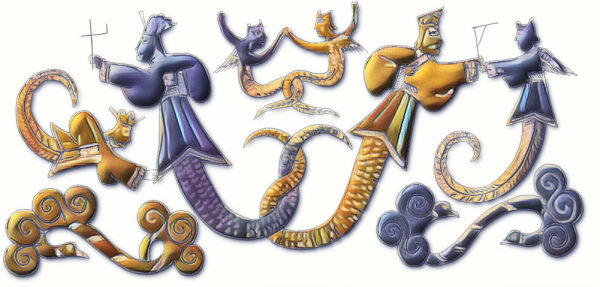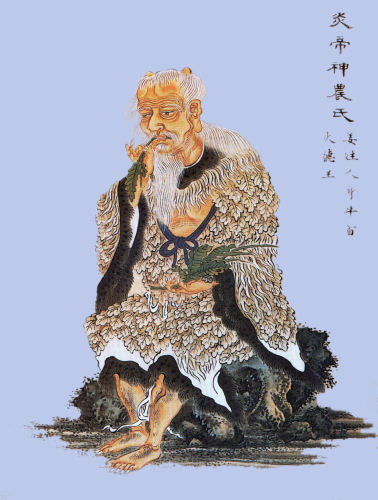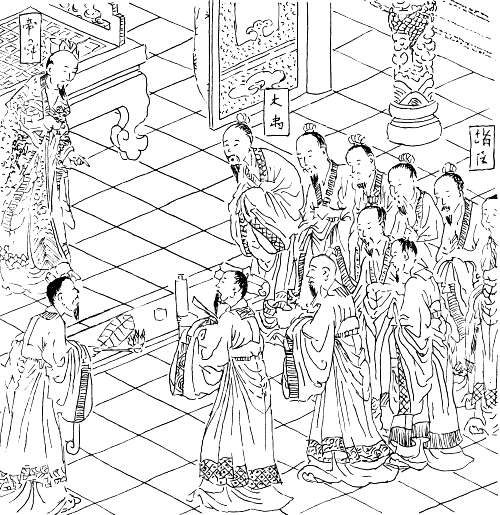Ancient Chinese gods and rulers
Here we describe the legendary rulers of ancient China. These are the ancient gods and rulers that are separate to the folk deities we describe elsewhere.
The earliest legendary gods in China are put into a category labeled ‘Three Sovereigns and Five Sage Emperors’. The first group are gods while the second are the first legendary rulers of China.
The Three Sovereigns 三皇 Sān huáng
This hazy collection of sovereigns/emperors/gods are bound up with the earliest legends in China. Up until relatively recent times there was no creation legend, (the legend of Pangu probably came from outside China) and there was no legend of heaven or hell. Life all started with a semi-god creation figure Fuxi and his wife or sister Nuwa. Most creation myths also include the discovery of yin & yang and then the eight trigrams.
The other two figures of the trinity of ‘Three August Ones’ varies from historian to historian, reflecting the fact that the legends of several tribes merged at an early date. The most widely known set of three are Fuxi, Shennong and then the Yellow Emperor. Other candidates are Zhurong 祝融 (god of fire); Gonggong 共工 (god of water) and Suiren 燧人.

Fuxi 伏羲 Fú xī
Fuxi is credited as a great inventor, perhaps most important culturally are the eight trigrams that he saw on the back of a tortoise. These were combined with each other to form the 64 gua of the Yi Jing. Fuxi was reputedly born at Chengji, now Tianshui in modern day Shaanxi. He taught people how to fish, hunt, keep flocks, measure distance, and spin silk. Other inventions include musical instruments (made from silk threads), the calendar, marriage ceremony, characters for writing, and the cooking of food. His name name means literally ‘hidden victim’ from his teaching how to use nets and snares. There are many and various depictions but he is only a minor figure compared to the Yellow Emperor. He reputedly lived at Chen 陳 now Huaiyang in modern day Henan and traditional reign dates are 2852-2737BCE. His head is sometimes said to have had four faces (perhaps representing the four ministries of state).
Nüwa 女娲 女娲 Nǔ wā
Nuwa (also known as Nügua) is the goddess of matchmakers and also a goddess of the moon. She was the brother or husband of legendary Emperor Fuxi and like him has the body of a snake (or snail) with a human head. As the first couple Nuwa drew up the marriage laws that forbade incest and codified the conduct of engagements and weddings. There is a story of how she used stones of five colors to mend a rift in the sky. There are many conflicting creation fables about her, so she probably is one of the most ancient Chinese deities, she is fabled to have invented music and even humanity itself by modeling people from clay. The creation of mankind by Nuwa is celebrated on the seventh day of the New Year festivities. Fuxi and Nuwa are often depicted with their snake-like bodies entwined together.

Shennong 神农 Shén nóng
Shennong was the god of farming and medicine and the successor to Fuxi. Reputed to have lived 2953-2838BCE. He made note of the benefits and dangers of using particular plants for food and medicine. He grew the five grains 五谷 wǔ gǔ and hundred grasses. He moved the capital to Qufu, Shandong and is credited with the invention of the guqin (ancient zither). By tradition he was a son of the consort of the Yellow Emperor's father, the Emperor 少典 Shǎo diǎn. He is depicted with the head of a buffalo and a dragon's face. He is the legendary author of the famous 本草经 Běn cǎo jīng encyclopedia of medicinal plants but this was probably written in the early Han dynasty. He is also considered to have written the 神农书 Shén nóng shū which is an early book on agriculture, and with digging the first well.
Yandi 炎帝 Yán dì
He is the Fire or Red Emperor who may be same as Shennong and is by some considered a brother of the Yellow Emperor. There is a legend that Yandi (Red) and Huangdi (Yellow) fought great battles with each other before Huangdi eventually defeated him. Chinese people consider themselves descendents of ‘Yan’ and ‘Huang’.
Zhurong 祝融 Zhù róng
The god of fire has a number of legends associated with him. He has been dated back to a minister under the Yellow Emperor or a contemporary of Fuxi, he may also be just another name for Shennong. Legends have Zhurong as an assistant to the Red Emperor (Yandi). He is controller of fire, rather than bringer of fire, as he can put them out as easily as start them. He is associated with the warm south and is depicted riding two dragons. He may also be accompanied with other fire-related attendants: birds, serpents, fireballs and fire-wheels. He is commemorated on the 17th day of the 8th lunar month when people seek his protection from fire.
Suiren 燧人 Suì rén
Sometimes included as one of Three Sovereigns. Introduced the knowledge of how to use fire, particularly the cooking of food.
Gonggong 共工 Gòng gōng
The god of water and sometimes included as one of Three Sovereigns. Believed to be a descendent of the Red Emperor. He is best known for taming floods.
Five Legendary or Sage Emperors 2696-2100BCE
Following the Three Sovereigns the golden age of the Sage Emperors began with the Yellow Emperor who was then followed by Zhuanxu, Ku, Yao and Shun. These are more like super-humans than gods. The Five Emperors (五帝 wǔ dì) ruled with perfect wisdom and is often referred back to in poems and literature as a lost Golden Age which everyone seeks to recreate. The end of the era comes with the foundation of the first historical dynasty - the Xia in around 2100BCE. Many of the stories about these early figures were collected by the great historian Sima Qian's famous ‘Records of the Grand Historian’ each is said to have made some important contribution to Chinese culture (tea, silk, agriculture, administration, fishing, weiqi, calendar, Yi Jing, medicine and so on).
Yellow Emperor or Huangdi 黄帝Huángdì [2718 BCE - 2598 BCE]
Huangdi, the Yellow Emperor ➚ is credited with inventing many of China's key technologies including copper-ware, the wheel, armor, boats, pottery and also characters for writing. Huangdi is also the god of architecture. His wife, the Empress Léi zǔ 嫘祖 , is said to have pioneered innovations such as silk production. The traditional numbering of years starts at the year of the Yellow Emperor's birth. He is considered the founder of the nation of China and all Chinese Emperors and people claim descent from him. At the end of his reign the appearance of a phoenix and qilin demonstrated heaven's approval for his wise reign. He is both the last of three sovereigns (三皇 sān huáng ‘Three august ones’) of a legendary demi-god status and the first Sage Emperor.
The term ‘yellow’ comes from the name of the time period in which he lived, each period was named according to the cycle of Daoist five elements and ‘yellow’ is associated with the ‘earth element’. His capital was at Jingshan near Kaifeng,Henan and Huangdi's burial place is reputed to be at Huangling north of Xi'an.
Emperor Zhuanxu 颛顼 Zhuān xū Chuan Hsiu WG
Emperor Zhuangxu had a spirit of fire and served as minister to Yellow Emperor. He was a grandson of the Yellow Emperor. Traditional reign date: 2513-2435 B CE.
Emperor Ku 帝喾 Dì kù
The third Sage Emperor succeeded Emperor Zhuangxu and was a great grandson of Yellow Emperor but not a son of Zhuanxu. Ku lived at Bo (present day Kaifeng) in Henan.
Emperor Yao 尧 Yáo 2333 - 2234 BCE
After a miraculous birth Yao took the throne in 2357BCE and after ruling wisely for 70 or so years abdicated in favor of Emperor Shun 帝舜. He is said to have had eyebrows of eight different colors. Some say he was a great-grandson of the Yellow Emperor. He ruled over a period of peace so long that cockerels were found on top of war drums as they had been cast aside for so long - and this is why a cockerel on a drum became an emblem of peace. Yao is attributed as the inventor of writing/painting brush. He is said to have lived simply and wore animal skins. He had ten sons but he chose Shun as a more worthy successor than any of them. Shun is said to have proved his skills by escaping from a forest during a storm. This made the important precedent of choosing people on the basis of skill rather than family relationship. Emperor Yao is credited with devising the calendar and the system of rituals. He is regarded as the model Emperor against whom all other emperors were measured and found lacking. Confucius frequently lauds Yao for demonstrating the correct way to rule.
He is also known as 唐尧 Táng yáo, with given name 放勋 Fàng xūn. He renamed his kingdom Tang with capital at Pingyang 平阳 píng yáng (now Linfen) in Shanxi. By his time social customs had been established and different grades of Imperial officials had been created.

Emperor Shun 虞舜 Yú shùn 2294 - 2184 BCE
Said to have been born near Mount Yumu, Hengyang in Hunan, Shun had semi-barbarian origin, but grew to be a respected king. He was disliked by his blind father who favored another son but Shun still remained loyally filial to him. At age 20 he served Emperor Yao who then made him his heir and gave him two of his daughters in marriage. He had great mental and physical strength and is said to have had double pupils in his eyes. He ruled the kingdom which he named ‘Yu’ with capital at Pingyang, Shanxi. The rulers of the kingdom of Chen claim descent from him. On his death he was canonized as 邘帝舜 Yú dì shùn.
Yu the Great 大禹 Dà yǔ 2123 - 2025 BCE
Yu the Great was a legendary Emperor who succeeded Emperor Shun as the founder of the Xia dynasty. Some say his place of birth was Shiquan, Sichuan. He worked under Emperor's Yao and Shun to save China from a great flood by diverting the rivers. The flood, often compared to the Noah's Biblical flood ➚ lasted 13 years with waters to the tops of mountains. (There is archaeological evidence for an earthquake that caused a great flood on the Yellow River at this time). While building flood protections he saw a tortoise with the first writing on its back which stimulated moral teaching and the uncovering of the secrets of unseen.
He then became the first emperor of Xia dynasty around 2205BCE, some say Emperor Shun made him Emperor as a reward for his flood prevention work. He is said to introduced the concept of the nine cauldrons that represented the nine regions of China and ownership of them gave the right to rule all of China. He chose 伯益 Bó yì as his successor but Yu's son Qi killed Bo Yi and usurped the throne. Yu's grave is said to be at Yuling near Shaoxing, Zhejiang.